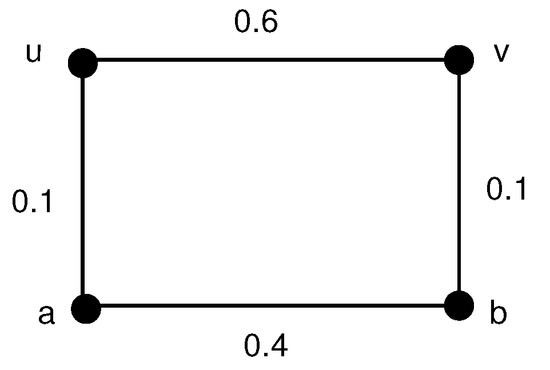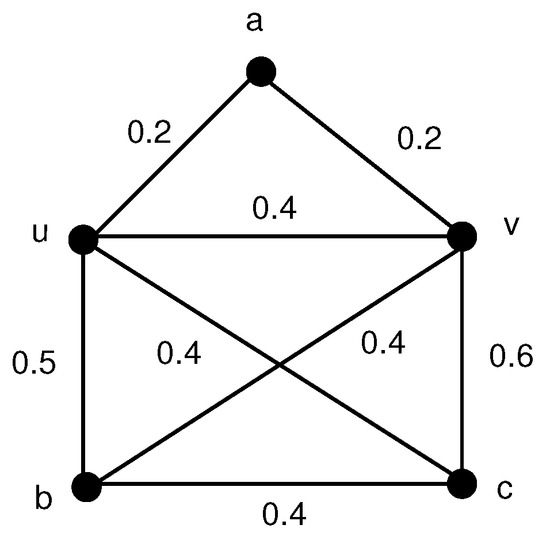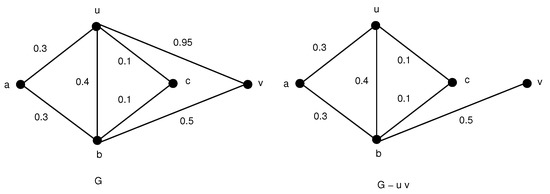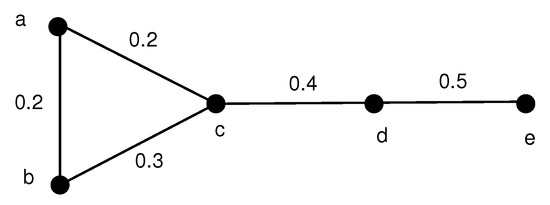Abstract
Connectivity parameters have an important role in the study of communication networks. Wiener index is such a parameter with several applications in networking, facility location, cryptology, chemistry, and molecular biology, etc. In this paper, we show two notes related to the Wiener index of a fuzzy graph. First, we argue that Theorem 3.10 in the paper “Wiener index of a fuzzy graph and application to illegal immigration networks, Fuzzy Sets and Syst. 384 (2020) 132–147” is not correct. We give a correct statement of Theorem 3.10. Second, by using a new operator on matrix, we propose a simple and polynomial-time algorithm to compute the Wiener index of a fuzzy graph.
1. Introduction
In many real world problems we get only partial information about the problem, and the vagueness in the description and uncertainty has led to the growth of fuzzy graph theory. A mathematical framework to describe uncertainty in real life situation was first suggested by A.L. Zadeh [1]. Rosenfeld [2] introduced the notion of fuzzy graph and several fuzzy analogs of graph theoretic concepts such as paths, cycles and connectedness. Wiener index of graphs has been studied in the field of mathematics, chemistry, and molecular biology [3,4,5].
There are many situations which are modeled by a connected fuzzy graph. Wiener index is such an accepted index used in various fields like communication networks, facility location, crytopology, medicine, etcs. Let us start with a basic definition and concepts of fuzzy graphs; most of them can be found in [6].
Let S be a set. A fuzzy graph is a pair of membership functions on fuzzy sets and such that . Here ∧ represents the minimum. Throughout the paper, we assume that S is finite and nonempty, is reflexive and symmetric. We denote the underlying crisp graph by where and . We denote an element of by and call it an edge of G. Elements of are called vertices of the fuzzy graph G. A fuzzy graph is called a partial fuzzy subgraph of if for all and for all . Note that denotes the fuzzy subgraph of G in which and is used for the fuzzy subgraph of G in which .
In a fuzzy graph , a path P of length n is a sequence of distinct vertices such that , and the degree of membership of a weakest edge is defined to be the strength of the path P. A path P is called a cycle if .
For any two vertices x and y, let denotes the length of the shortest path between x and y. The diameter of G, denoted by , is the maximum distance for any two vertices x, y in G. The strength of connectedness between two vertices x and y is defined as the maximum of the strengths of all paths between x and y and is denoted by . If the strength of a path P is equal to , then a path P is called a strongest path. A fuzzy graph is connected if for every , . An edge of a fuzzy graph is called -strong if An edge of a fuzzy graph is called -strong if An edge of a fuzzy graph is called -strong if An edge is called strong if it is either -strong or -strong. A path P is called a strong path if all of its edges are strong. Let be a fuzzy graph and A strong path P from x to y is called geodesic if there is no shorter strong path from x to y. The weight of a geodesic is the sum of membership values of all edges in the geodesic. Let be a fuzzy graph. The Wiener index (WI) of G is defined by , where is the minimum sum of weights of geodesic from u to v. In this paper, it is assumed that for in all examples of fuzzy graphs , for convenience. The outline of this paper is organized as follows. In Section 2, it is shown that Theorem 3.10 in the paper “Wiener index of a fuzzy graph and application to illegal immigration networks, Fuzzy Sets and Syst. 384 (2020) 132–147” is not correct. A corrected statement of Theorem 3.10 is given. In Section 3, we present a simple algorithm to compute the wiener index of a fuzzy graph by using a new operator on matrix.
2. Counterexamples and Revision
At first, we recall the Theorem 3.10 of [7] and give two counterexamples to it.
Theorem 1
(Theorem 3.10 of [7]). Let be a fuzzy graph. For , let denote the path which has the minimum sum of membership values among all shortest strong paths between s and t. Let . If is an α or β-strong edge and is not a part of any for with , then .
Theorem 3.10 of [7] is not correct as shown in the following two counterexamples. In the following two graphs, is an -strong edge and -strong edge, respectively.
Example 1.

Let be the fuzzy graph shown in Figure 1 with vertex set and for any , , , , . Then each edge of the graph G is strong. So , , , , and . Therefore, . It is obvious that is an α-strong edge and is not a part of any for with . For any two vertices , the number in is equal to the number in G. Then and .

Figure 1.
is an -strong edge and .
Example 2.

Let be the fuzzy graph shown in Figure 2 with vertex set and for any , , , , . Then each edge of the graph G is strong. So , , , , and . Therefore, . It is obvious that is an β-strong edge and is not a part of any for with . For any two vertices , the number in is equal to the number in G. So and .

Figure 2.
is an -strong edge and .
Therefore, Theorem 3. 10 of [7] can be changed as follows
Theorem 2.
Let be a fuzzy graph with each edge being strong. For , let denote the path which has the minimum sum of membership values among all shortest strong paths between s and t. Suppose that is not a part of any for with . Then
(1) If , then .
(2) If , then .
(3) If , then .
Proof.
Since each edge of G is strong, it follows that each edge in is also strong edge. Owing to being a strong edge in G, . Let . Since is not part of any , . Thus, . So, if , then . If , then . If , then . □
Note: The condition “each edge is strong” is necessary in Theorem 2. For example, let be the fuzzy graph shown in Figure 3 with vertex set and for any , , , , , . Then each edge of the graph G except edge is strong. Edge is a weak edge in G. So , , , , , , and . Therefore, . It is obvious that is a strong edge and is not a part of any for with . It is obvious that is a strong edge in . Hence, , , , , , , and . So . Though , .

Figure 3.
Fuzzy graphs G and .
3. A New Algorithm to Compute Wiener Index of a Fuzzy Graph
Let be a fuzzy graph with . The underlying graph of is denoted by , where and . M. Binu et al. in [7] give an Algorithm 1 to compute Wiener index of a fuzzy graph as follows.
| Algorithm 1: Computing Wiener index of a fuzzy graph [7]. |
|
The main drawback of the Algorithm 1 in [7] is as follows.
Dijkstra’s algorithm is only used to identify the length of the shortest path between u and v in . However, it can not be used to identify the number k of the shortest path. For any big graph, the total number of the shortest path between u and v can be very high. In such case, it is difficult to perform Step 3 and Step 4.
In order to give a simple algorithm to compute Wiener index of a fuzzy graph , we define an operator ⊛ on matrix as follows. Let be the fuzzy subgraph of G obtained by deleting the -edges of G. Let be the adjacent matrix of the fuzzy graph , where and for . Let for , where denote the diameter of . Define as follows:
Theorem 3.
Let be a fuzzy graph such that every edge is strong edge. If and , then and , where is the distance between and in .
Proof.
We will prove it by induction on the number k. Suppose . If , then and . Since every edge in is strong edge, then and . Suppose that and . Then . Since , it follows that and .
Assume that the theorem holds for . Suppose that and . By definition, . For any and , if there exists such that , then . Since , it follows that , which is a contradiction. Hence for any , . That is and . By inductive hypotheses on k, it follows that and . Since , there exists t such that , where and . Since and , it follows that and . □
Corollary 1.
Let be a fuzzy graph such that every edge is strong edge. Let be the diameter of . Then for any two vertices , , where .
| Algorithm 2: A new algorithm to compute Wiener index of a fuzzy graph. |
Step 1. Identify strong edges of G using the algorithm in [8]. Step 2. Let be the fuzzy subgraph of G obtained by deleting the -edges of G. Step 3. Calculate , where for . Step 4. Calculate . |
Obviously, it is a polynomial-time algorithm. The correctness of the Algorithm 2 follows from Theorem 3 and Corollary 1. So we have the following:
Theorem 4.
Let be a fuzzy graph. Let be defined as in the Algorithm 2. Then .
Proof.
By Theorem 3, let be a fuzzy graph such that every edge is strong edge. If and , then and . By the definition on the new operator on matrix, for any two vertices , , where . So, . □
Example 3.

Let be the fuzzy graph shown in Figure 4 with vertex set and for any , , , , , . Then each edge of the graph G is strong.

Figure 4.
Fuzzy graph G with .
By using Algorithm 2 and , we can compute and as follows:
|
|
| a | b | c | d | e | |
| a | 0 | 0.2 | 0.2 | 0.6 | 1.1 |
| b | 0.2 | 0 | 0.3 | 0.7 | 1.2 |
| c | 0.2 | 0.3 | 0 | 0.4 | 0.9 |
| d | 0.6 | 0.7 | 0.4 | 0 | 0.5 |
| e | 1.1 | 1.2 | 0.9 | 0.5 | 0 |
As membership values of all vertices are one, the sum of all upper triangular entries of will be the of G. Hence .
4. Conclusions
In this work, we discussed two problems related to the Wiener index of a fuzzy graph. First, we argued that Theorem 3.10 in the paper “Wiener index of a fuzzy graph and application to illegal immigration networks, Fuzzy Sets and Syst. 384 (2020) 132–147” is not correct. We gave a correct statement of Theorem 3.10, where a different result is given for the same conditions. Second, by using a new operator on matrix, we proposed a simple algorithm to compute the wiener index of a fuzzy graph. The main contribution of the proposed algorithm is as follows: First, for a general fuzzy graph, computation of the Wiener index by hand is possible. At the same time, the algorithm is easily realized in the computer. Furthermore, the new algorithm is simpler and more efficient, which is a polynomial-time algorithm. The property on Wiener index can help us to understand the critical property on the communication network. That is, when some edge is deleted, the Wiener index in communication network may be changed.
Author Contributions
The contributions of all authors are equal. All authors have read and agreed to the published version of the manuscript.
Funding
This research was supported by the Basic Science Research Program through the National Research Foundation of Korea (NRF) funded by the Ministry of Education (2020R1I1A3A04036669).
Conflicts of Interest
The authors declare no conflict of interest.
References
- Zadeh, A.L. Fuzzy sets. Inf. Sci. 1965, 8, 338–353. [Google Scholar] [CrossRef] [Green Version]
- Rosenfeld, A. Fuzzy graphs. In Fuzzy Sets and Their Applications to Cognitive and Decision Processes; Zadeh, L.A., Fu, K.S., Tanaka, K., Shimura, M., Eds.; Academic Press: New York, NY, USA, 1975; pp. 77–95. [Google Scholar]
- Dobrynin, A.A.; Gutman, I.; Klavžar, S.; Žigert, P. Wiener index of hexagonal systems. Acta Appl. Math. 2002, 72, 247–294. [Google Scholar] [CrossRef]
- Knor, M.; Skrekovski, R.; Tepeh, A. Mathematical aspects of Wiener index. Ars Math. Contemp. 2016, 2, 327–352. [Google Scholar] [CrossRef] [Green Version]
- Wiener, H. Structural determination of paraffin points. J. Am. Chem. Soc. 1947, 69, 17–20. [Google Scholar] [CrossRef]
- Mathew, S.; Mordeson, J.N.; Malik, D. Fuzzy Graph Theory; Springer: Berlin/Heidelberg, Germany, 2018. [Google Scholar]
- Binu, M.; Mathew, S.; Mordeson, J.N. Wiener index of a fuzzy graph and application to illegal immigration networks. Fuzzy Sets Syst. 2020, 384, 132–147. [Google Scholar]
- Mathew, S.; Sunitha, M.S. Types of arcs in a fuzzy graph. Inf. Sci. 2009, 179, 1760–1768. [Google Scholar] [CrossRef]
Publisher’s Note: MDPI stays neutral with regard to jurisdictional claims in published maps and institutional affiliations. |
© 2021 by the authors. Licensee MDPI, Basel, Switzerland. This article is an open access article distributed under the terms and conditions of the Creative Commons Attribution (CC BY) license (https://creativecommons.org/licenses/by/4.0/).